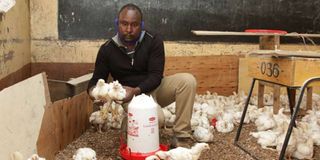Premium
Why 55,000 learners have no school to return to

Lincoln Njogu, director at Ndima Kanini Academy-Karatina, tends to his chicks inside one of the classrooms on August 24, 2020. The institution turned to poultry farming to generate income after closure of schools in March.
What you need to know:
- Whistling Thorn School in Kawangware Dangoretti North is among schools that turned the classrooms into rental houses and learners had to look for admission in other schools.
- Some public primary schools have more than 4,000 pupils.
The fate of 55,000 learners from private schools hangs in the balance after their institutions failed to open last Monday.
Now thousands of learners in in Grade Four, Standard 8 and Form Four are seeking admission in public schools, amid major concerns of a lack of capacity when all learners resume classes in a weeks’ time.
So far, more than 200 private primary and secondary schools have shut down, with their owners turning them into business premises or handing them back to the landlords.
Whistling Thorn School in Kawangware Dangoretti North is among schools that turned the classrooms into rental houses and learners had to look for admission in other schools.
Kenya Private Schools Association chief executive Peter Ndoro told the Sunday Nation that 207 schools did not resume business.
“The number even be higher, as not all schools are members of the association,” he said.
Mr Ndoro said owners of the affected learning institutions have advised parents to transfer their children to other schools.
Of concern is the future of the candidates who will have to sit exams in other schools.
Examination centres
Mr Ndoro said the affected schools are working with the Ministry of Education and the Kenya National Examination Council to make arrangements for alternative examination centres for the affected candidates to enable them sit the national examinations scheduled for March next year.
Experts say the Covid-19 pandemic has exposed the need by the government to invest more in public schools. Already, public schools are overcrowded and have no capacity to take in own learners when they fully reopen.
There is an acute shortage of teachers, with the teacher to learner ratio remaining a great challenge.
In 2002, the government introduced the Free Primary Education in public schools, stretching their capacity.
Some public primary schools have more than 4,000 pupils. Olympic Primary School in Kibera and Mwiki Primary School in Kasarani in Nairobi fall in this category.
In most public schools, classrooms hold at least 50 students while others hold up to 80.
Statistics from the Ministry of Education indicate there are more than 18 million school-going children in Kenya. At least 3.2 million are in pre-primary school while 15 million are in primary and secondary schools.
The population in primary schools is estimated to be slightly more than 10 million in 31,218 primary schools while 8,747 secondary schools host five million learners.
2.5 million learners
Kenya has a total of 11,000 private schools with a capacity of 2.5 million learners.
Out of the total, 9,800 are primary schools with a capacity of Sh2.3 million pupils while 1,600 are secondary schools with a capacity of 274,000 students.
The situation in schools could even be worse when the other leaners resume in two weeks.
Learners in Grade One to Three, Standard Five to Seven and those in Form One to Three are expected to resume school from October 26 despite the Covid-19 cases increasing.
Currently, learners are sitting at a distance of 1.5 metres from each other as schools observe the Covid 19 health guidelines.
This has caused many schools to limit the number of learners to a maximum of 25 with others holding only 15 learners.
In other schools, nearly half of all classes have been occupied by the Grade Four and Standard Eight leaners who reported last week.
When the other classes resume, learners may be forced to sit outside classrooms as they observe social distancing.
For private schools, Mr Ndoro admitted that they have limited by resources.
Private institutions have been struggling to remain a float with the majority unable to run their operations.
Nearly all are grappling with huge debts from suppliers while others have shifted to other businesses as the pandemic continues to impact global economies negatively.
So acute is the situation that several schools sold their property to mitigate the situation while others fell on the auctioneers hammer due to defaults on loans.
School administrators, directors and proprietors of these schools say they have been experiencing a financial shock
The schools have, however, said they would not relent on the issue of school fees as they will have to pay bills.
Paying school fees
“We asking our parents to support our schools by paying school fees. We will need the money to ensure that we pay our teachers and also meet all health guidelines,” said Mr Ndoro.
Some schools such as Diwopa Catholic Primary School asked parents to clear their Term One arrears and pay term two school fees as the school reopened.
This is despite Education Cabinet secretary George Magoha asking principals to ensure that no child is sent home because of school fees whether in private or public schools
Mr Ndoro said: “It is the obligation of our parents to pay school fees. Our parents will be expected to adhere to the rules,”
He added that most of the schools are, however, facing major challenges of some learners transferring to other schools.
“So far 85 per cent of our learners resumed. However, we have a number of learners who didn’t resume,” he said.
The transfer of children has also been a burden to parents as they buy new school uniforms for their children.





